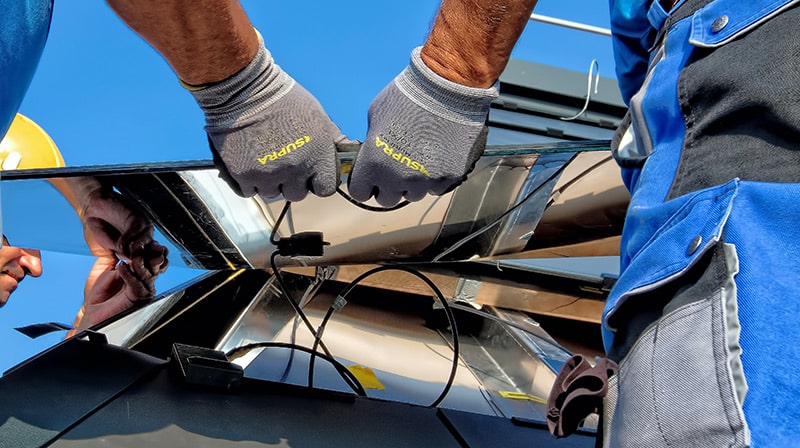Can I install solar PV on asbestos roofing?
A potential issue arises, however, if the site where you are thinking of having a solar PV installation carried out happens to be a roof made from asbestos.
The short answer to the question of whether you can install solar PV panels on an asbestos roof, is yes. However, drilling into an asbestos roof is not recommended if you can at all avoid it. With asbestos being a notorious carcinogen, you will need to take great care to only carry out this process in a manner that minimises health risks.
Below, we will explore in greater detail how that might be accomplished.

The dangers of drilling into asbestos roofing
As we have touched on, drilling into an asbestos roof is not a recommended course of action, if it is at all possible, it should be avoided. However, if the task is carried out by suitably competent and trained people and the correct control measures are in place, it is possible to drill into asbestos cement safely.
Nonetheless, the process of drilling into asbestos roofing can also bring very real dangers, such as those outlined below.
Asbestos fibre release
One of the reasons why one should only apply the most extreme caution to the task of drilling asbestos roofing tiles, is the considerable scope this process presents for asbestos fibres to be released into the air.
If loose asbestos fibres are released as a consequence of drilling into the cement material – as can especially easily happen when high-speed drilling equipment is used – these fibres may be ingested or inhaled by someone nearby.
In the event of this happening, it can elevate the exposed individual’s risk of developing a potentially fatal asbestos-related disease, such as mesothelioma or asbestos-related lung cancer, even many decades after the incident of exposure occurred.
Uncontrolled dust dispersal
We mentioned above that the appropriate control measures – for example, the containment of the given work area through the erection of a temporary barrier – are important for minimising the risk if the decision is made to go ahead with drilling into an asbestos roof.
We are, after all, referring in this article to your building’s roof, which is a part of your property that is in the open air. Once asbestos particles are released as a consequence of disturbance, in the absence of effective control measures, they could very easily spread to other areas, such as neighbouring properties, and cause asbestos contamination to them as well.
So, putting in place the right control measures prior to drilling into your asbestos cement roof for the purposes of a solar PV installation, is not merely something you should be doing to help protect yourself. Given how unpredictable the dispersal of asbestos dust can be, implementing the correct mitigations is also something you should be doing to protect others.
Risk to individuals
Although it would be an obvious point to make that solar PV installers and anyone else who is working on your roof during this time could be at risk in the event of asbestos fibres being released, this is not necessarily the start and end of the list.
Such is the severity of the health hazard, even passers-by – and indeed, anyone who occupies or uses the affected property, or the buildings immediately nearby – could be at risk if you do not put in place responsible measures for controlling that risk when drilling asbestos roofing.
Complexity of safe practices
The UK Health and Safety Executive has set out various guidelines for how to safely drill holes in asbestos cement roofing or other highly bonded materials containing asbestos.
These guidelines encompass such steps as preparing the work area before the work begins, by ensuring safe access and restricting access to the rear of the asbestos material (which, in the case of drilling an asbestos roof from the outside, would mean segregating the area underneath the roof). The HSE guidelines also include having the right equipment on hand, such as a drill set at the lowest speed, and sealing the drilled edge with sealant.
From a HSE perspective, drilling into asbestos cement is a non-licensed activity – in other words, it is not strictly necessary to hire an HSE-licensed contractor in order to carry out the above work.
However, safety practices like the aforementioned are frequently complex ones that not everyone will be able to easily execute. In practice, only those with professional expertise and specialised equipment are likely to successfully implement all the necessary measures.
For these reasons, we would certainly strongly advise you to consider hiring a licensed professional to undertake such a sensitive job as the drilling of asbestos roof cement.
Legal and liability issues
Being sensible and responsible in how you approach the drilling of asbestos roofing (if you choose to do so at all) isn’t merely a matter of health and safety; it could also open you up to adverse legal consequences if you contravene relevant regulations.
So, before you proceed with this process, you should look into the asbestos-related legislation, such as the Control of Asbestos Regulations 2012 (CAR 2012), that may affect you and your management of the property.
Fines running into tens of thousands of pounds, and even prison sentences, have been handed down in the past to those who have broken the stringent asbestos-related laws that exist in the UK today. So, you should not be treating this factor lightly.
Contamination and cleanup concerns
It is not even merely the drilling itself that requires great care and responsibility to be taken, as once this essential work has been done, there will be a need for thorough and costly cleanup.
The HSE’s own best practice guidelines on the drilling of holes in asbestos cement, include using a Class H vacuum (if available) and/or damp rags to clean the equipment used and the affected area. It will also be necessary to place debris, used rags, polythene sheeting, paintbrushes, and other waste into an asbestos waste bag. That bag, in turn, will need to be put in a clear polythene bag, which must then be taped closed and disposed of in a responsible and legally compliant manner.
As you can see, even this cleanup process can be complex, and any failure to follow best practice in any aspect of that process could put the health of cleanup crews and building occupants at risk.
Alternatives to installing solar PV panels on asbestos roofing
So, if it is best to do everything possible to avoid directly drilling into an asbestos roof in order to install a solar PV system, what are some of the other possibilities you might consider? We have set out a few below:
Non-penetrative mounting systems
There could be various possibilities – depending on the nature of your specific property – to have solar PV panels installed in a manner that does not involve any direct penetration of the asbestos cement.
It might be possible, for example, to have the asbestos roof overclad with steel, which would then provide a stable, load-bearing base for solar installation.
This would also bring the benefit of giving your roof an additional layer of insulation – albeit, with the downside of asbestos still being present in the building.
Relocating solar panels
Solar PV systems may frequently be installed on roofs, but there isn’t an automatic rule that such a system needs to be based on a roof at all.
You could, for instance, consider a ground-mounted solar system if you have the space available at your site.
Another type of installation – which has gained greater popularity in the UK in recent times – is the mounting of solar panels on carports (which are shelters suitable for cars). Again, this might be a much more feasible option for some sites, than it is for others.
Roof removal and remediation
If you have the financial resources to do it, and the existing asbestos roof at your site is presenting too much difficulty, why not consider having the asbestos roof removed and replaced altogether, with a new corrugated steel roof?
Yes, this would be an expensive course of action compared to the others in this list. But it would also save you from any longer having to worry about asbestos in this part of your property at all, making it one of the most “futureproof” solutions for having a solar PV system installed.
If you must install solar PV panels on asbestos roofing, what do you need to know?
To reiterate what we stated above, if you do decide to go ahead with installing solar PV panels directly onto asbestos roofing – and we would hope you consider every possible alternative before doing so – we would urge you to at least think about engaging a licensed contractor.
Yes, this particular asbestos material is unlicensed under the present HSE regime. However, the second you begin drilling asbestos cement roofing, the potential for fibre release and exceeding the asbestos control limit will be high. If you do exceed the control limit, this will cause a spread of asbestos contamination.
The good news is that if you hire a licensed contractor to carry out this highly specialised and sensitive work, you can be absolutely confident that they will have the competency, experience, and equipment needed to put in place the correct control measures.
This, in turn, will enable them to carry out the drilling work as safely as possible, guarding against the risk of potential asbestos exposure and spread of contamination. After all, if either of those things were to occur in your case, they could be very costly from a health, monetary, and legal perspective. So, the hiring of a licensed professional could be a very sensible investment.
Conclusion: take care to explore the safest options for your solar PV installation
Hopefully, we will have made adequately clear to you in this article, just how risky the process of drilling into asbestos cement roofing for the purposes of solar PV installation can be. The dangers are likely to be especially high when the person carrying out the work is not suitably qualified, knowledgeable, and experienced, and/or does not make use of the right equipment to ensure safety.
The release of asbestos fibres from drilling into an asbestos roof can occur so easily. And once it does happen, you may have little control over where those fibres subsequently spread – and the people whose health they may imperil.
For these reasons, our team here at Oracle Solutions would always strongly emphasise the importance of exploring safer alternatives to the direct drilling of asbestos roofing.
The good news is that by taking responsible and legal approaches to how you install a solar PV system at your own property, you can help reap the considerable benefits such an installation can bring, without putting yourself – or anyone nearby – at avoidable risk.
To discuss in greater detail how our experts may be able to provide the accredited, licensed, and well-priced asbestos services that you require ahead of your solar PV installation or that of any other renewable energy solution, please don’t hesitate to reach out to us today.

Written by Mark Carter
Mark Carter is a renowned expert in asbestos management, offering clients vital guidance on compliance and safety. His expertise is invaluable for navigating asbestos regulations, ensuring both safety and legal adherence. Mark's role is central in providing effective asbestos-related solutions, helping clients achieve their business objectives with an emphasis on regulatory compliance and safety in asbestos management.
